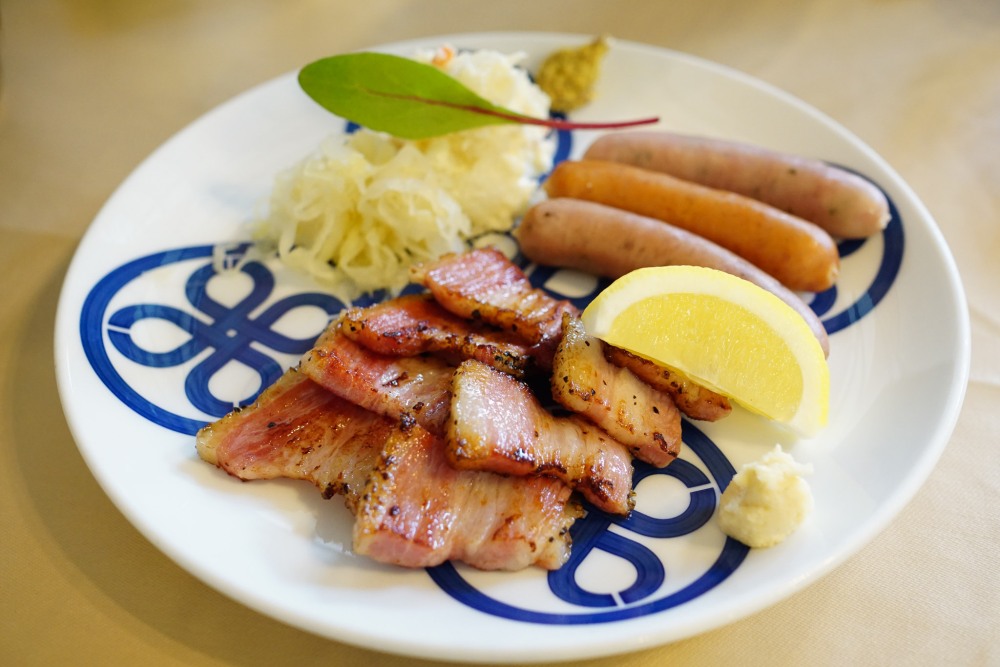Maisen Tonkatsu
Multiple locations throughout Tokyo
A morning stroll through Shinjuku Gyoen National Garden, was a beautiful way to pass the time in between breakfast and lunch. We saw many gorgeous cherry blossom trees and the crowds weren’t too bad. From there, we headed over to the Omotesando area of Shibuya. It is sometimes referred to as the Champs-Elysees of Tokyo, with its wide tree lined avenue of high end shops. Coming from Southern California, where there is no dearth of Louis Vuittons and Gucci stores, I just breezed down the avenue on our way to find “the best tonkatsu ever” per Smooth Obturator. My research also confirmed this opinion. While there are many locations of Maisen, including quick to-go counters within the depachikas of department stores throughout the city, Smooth Obturator told me I had to go to the location near Omotesando. We arrived shortly after opening around 11am to find people already waiting to be seated.

Maisen doesn’t just serve fried pork cutlets with sauce and rice. They delve deep into the world of pork. Their menu (thank God for an English version) explains their different cuts of pork (shoulder loin, loin, fillet, arm, pork belly, rumb) and brands of pork (Amai-Yuwaka, Okita-Kurobuta, Chamiton, TOKYO-X, Kurobuta, Benibuta) served. You can have your tonkatsu in any combination of cut and brand. I was a bit overwhelmed by the choices since Smooth Obturator didn’t apprise me of intricacies of Maisen. After reading through all the descriptions, I decided on fillet cuts of Kurobuta and TOKYO-X. Though, it seems like we should have stuck with loin as it is the fattier cut, which I did not know at the time.
Amai-Yukai Belly Ham Saute & 3 Sausage Assortment
Amai-Yukai is another brand of pork, described as “fine, soft texture accentuated with the delicious taste of sweet pork fat that melts on the tongue.” The belly ham was really a lovely marriage of the best things about pork belly and ham, the lush fattiness and the cured salty sweetness. The sausage had a good amount of fat incorporated, maybe too much making it a bit greasy. The differences between the 3 types were really subtle. It was well complemented by the whole grain mustard and pickled daikon which acted like a sauerkraut. Both were necessary components to help cut through the fat.


They essentially look the same, but the Kurobuta set comes with a red miso soup, instead of the white miso one shown below.
 Kurobuta was definitely the juicier of the two brands. The crunchy breading was the crispiest I’ve ever tasted. It was pure crunch through and through. I’ve never had katsu this crunchy. The Annoyer didn’t seem so impressed, but he’s not a huge fan of tonkatsu. He thought the breading was too crunchy and the pork was a tad dry. I will admit, I was expecting something juicier but we might have misstepped in ordering the fillet instead of the loin. Oh how order-regret is eating away at my foodie soul right now!
Kurobuta was definitely the juicier of the two brands. The crunchy breading was the crispiest I’ve ever tasted. It was pure crunch through and through. I’ve never had katsu this crunchy. The Annoyer didn’t seem so impressed, but he’s not a huge fan of tonkatsu. He thought the breading was too crunchy and the pork was a tad dry. I will admit, I was expecting something juicier but we might have misstepped in ordering the fillet instead of the loin. Oh how order-regret is eating away at my foodie soul right now!

There were 3 sauces served: your standard tonkatsu sauce, one a little more sweet, and one a little more spicy. I preferred to stick with the regular, while The Annoyer liked the sweetness of apples in the sweeter sauce.


Miso Soup
I liked the miso soup with the meat and vegetables which really enriched the broth with some fattiness and sweetness.


Meal sets in Japan are nice because they include dessert, even if it’s something as simple as fruit. Here we were presented with a small scoop of citrus sorbet. We debated for a while what kind of citrus and The Annoyer was insistent on it being yuzu but I thought it was more like orange. Of course, I was right.


9 – Awesome
8 – Very good
7 – Good
6 – OK
5 – Average
4 – Not bad
3 – Not good
2 – Terrible
1 – Do NOT eat here